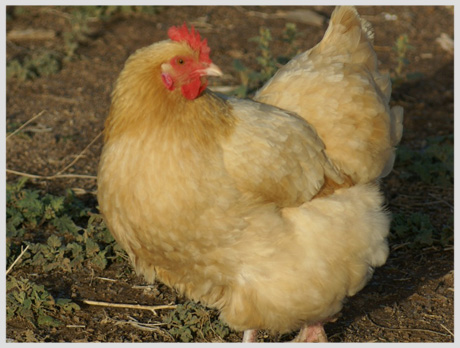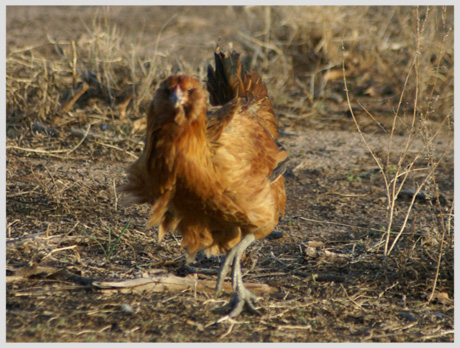What chicken breeds does Romey have?
Observational commentary and opinions on specific chicken breeds from Romey's "Wittmann Plantation."
 Buff Orpington – As long as we have chickens, we will never -not- have Buff Orpingtons. I don’t know if it’s because:
Buff Orpington – As long as we have chickens, we will never -not- have Buff Orpingtons. I don’t know if it’s because:
- The ones we have now are the last remaining breed of our original flock.
- The way their feathers flow as they waddle side to side when they run, adding to their already curious nature the whole family finds entertaining.
- The wit they have to be next to the horse bucket at feeding time to peck dropped oats.
- The fact that they are relatively easy to catch and handle.
- Their ability to flee and hide from predators.
- Their ability lay eggs as they free range (not return to the nesting boxes; there is a notable difference in egg production for other breeds if they can't get back to their box.)
- The consistency of their egg production
- Or the nick name their breed has been given at our homestead. We call them “Big Mama’s”
But they are far and away our favorite breed we have had to date and the one breed we always make sure we have a health laying stock of. NOTE: The one downside we of this breed is they tend to bully other breeds so I would not recommend keeping them mixed in with other breeds.
 Ameraucana – Growing up in New River my closest friend had Ameraucana’s. For me there is just something about the green eggs they lay that takes me back to my childhood years in New River, sitting at the Westfalls’ kitchen bar waiting for fresh eggs over easy with Alta’s famous biscuits and gravy. However, they are Amanda’s least favorite of the breeds we have had so far and resemble predator birds more than chickens in the way they look and move. They also peck the other chickens breed so bad we eventually eliminated them from our flock.
Ameraucana – Growing up in New River my closest friend had Ameraucana’s. For me there is just something about the green eggs they lay that takes me back to my childhood years in New River, sitting at the Westfalls’ kitchen bar waiting for fresh eggs over easy with Alta’s famous biscuits and gravy. However, they are Amanda’s least favorite of the breeds we have had so far and resemble predator birds more than chickens in the way they look and move. They also peck the other chickens breed so bad we eventually eliminated them from our flock.
Rhode Island Red – Reliable egg layer and nearly everyone who sells chicks, sells this breed so it’s good for beginners. No complaints in production, but we’ve lost more of this breed than any other…however, in talking to other chicken owners no one else notices a trend. Must be something with their red color the predators in our area seem to seek and destroy.
 Barred Rock – The girls consider this one of the prettier breeds; I think it’s just because they like the white stripe/polka-dot like pattern on the feathers. Personally, I don’t see it and I think they resemble game birds more than chickens. However, I will give them credit for undoubtfully being the most playful breed in the flock. We only have a few and to really get a good gauge on how well they are producing, I would have to isolate them as their eggs can’t always be distinguished from the other brown egg layers we have. When fully matured, the Barred Rock will have a full red comb.
Barred Rock – The girls consider this one of the prettier breeds; I think it’s just because they like the white stripe/polka-dot like pattern on the feathers. Personally, I don’t see it and I think they resemble game birds more than chickens. However, I will give them credit for undoubtfully being the most playful breed in the flock. We only have a few and to really get a good gauge on how well they are producing, I would have to isolate them as their eggs can’t always be distinguished from the other brown egg layers we have. When fully matured, the Barred Rock will have a full red comb.
Red Star –These were a gift from a friend who ordered too many chicks from McMurray Hatchery expecting at least half to die. However, all 30 were delivered alive, made it through last winter. Our neighbor ended up a year later with more eggs than refrigerator space. It took about two weeks before this breed started moving with the rest of the flock, but they did get adjusted and are productive layers.
Pearl Leghorn – This was our first white egg layer. They are still a few months away from POL (point of laying) and we really only picked this breed because if it’s what Hickman’s Family Farms use, they must be good egg layers.
Speckled Sussex – One practice we have in our flock is always trying different breeds. Sure they all have write-ups and people’s opinions, but we like developing our own “report cards” on the breeds. When we get a breed that gets a poor report card on the Romero Homestead, then we administer the score of “taste.” If we don’t start seeing production from this breed, the final score will soon be judged.
 Polish – This was a purchase for the girls. We were at Dale’s Country Store in Waddell picking up our annual chicks required to replace our yearly loss of natural causes and predators. They had a dozen or so of the Polish Breed in the holding pen, and we immediately started laughing at the fuzzy, yellow, dome- shaped feathers on their heads and thought the girls would get a kick out of it, too. Once home, the girls instantly flocked to this bird they named “Afro.” Now that it has matured the name has shifted to “Deville” after Disney’s Cruella Deville because of the black and white feathers the yellow afro has morphed into…or at times we call her Cuckoo. This breed also has a green tent on the end of its feathers when you see it direct sunlight and a red wattle. It’s a smaller breed and so are the eggs, but this is really just a novelty to the flock and primarily there for amusement.
Polish – This was a purchase for the girls. We were at Dale’s Country Store in Waddell picking up our annual chicks required to replace our yearly loss of natural causes and predators. They had a dozen or so of the Polish Breed in the holding pen, and we immediately started laughing at the fuzzy, yellow, dome- shaped feathers on their heads and thought the girls would get a kick out of it, too. Once home, the girls instantly flocked to this bird they named “Afro.” Now that it has matured the name has shifted to “Deville” after Disney’s Cruella Deville because of the black and white feathers the yellow afro has morphed into…or at times we call her Cuckoo. This breed also has a green tent on the end of its feathers when you see it direct sunlight and a red wattle. It’s a smaller breed and so are the eggs, but this is really just a novelty to the flock and primarily there for amusement.
Cornish Cross – An uglier chicken we have not had. This breed grows so fast their bones and feathers can’t keep up; they look like they have “mange” shortly after hatching. Be careful in the number you order at one time because when they are ready for harvest you have to harvest them all before they start dying as their body weight grows to be more than their legs can handle and they lose the ability to move to food and water. However, once harvested, you have a good, fresh supply of white chicken breast (in our experience there is not enough meat to harvest wings or legs) for multiple meals. An order of six every two weeks proves to be plenty for the family dinner table.
We are currently waiting for a February delivery on a new order of meat breeds from McMurray Hatchery that will be a first for us which consist of the Cornish Rocks, Cornish Hens and the Red Ranger Broiler. We’ll update this post once we have a report on their taste...as taste reaslly is the only score a broiler/fryer can earn. If you have ever own or seen one, you know exactly what I mean.
Books, Feed Stores, Hatchery’s, Supplies, Equipment and more to help get you started with your our backyard chick farm can be found on our Chicken Resource Guide.
